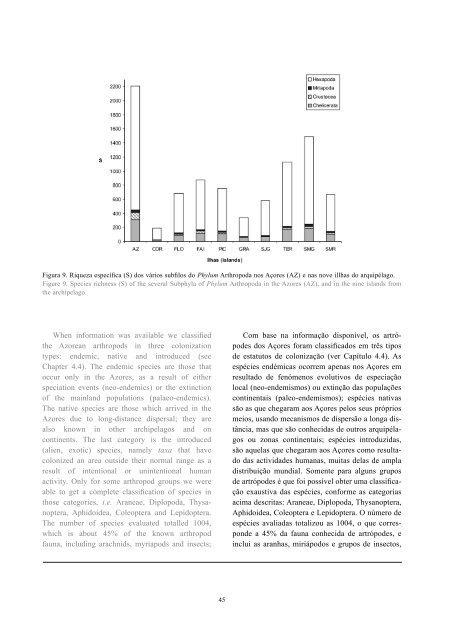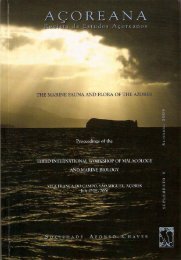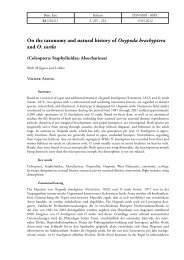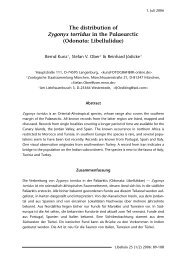(eds.) (2005). - Portal da Biodiversidade dos Açores - Universidade ...
(eds.) (2005). - Portal da Biodiversidade dos Açores - Universidade ...
(eds.) (2005). - Portal da Biodiversidade dos Açores - Universidade ...
You also want an ePaper? Increase the reach of your titles
YUMPU automatically turns print PDFs into web optimized ePapers that Google loves.
Figura 9. Riqueza específica (S) <strong>dos</strong> vários subfilos do Phylum Arthropo<strong>da</strong> nos <strong>Açores</strong> (AZ) e nas nove illhas do arquipélago.<br />
Figure 9. Species richness (S) of the several Subphyla of Phylum Arthropo<strong>da</strong> in the Azores (AZ), and in the nine islands from<br />
the archipelago.<br />
When information was available we classified<br />
the Azorean arthropods in three colonization<br />
types: endemic, native and introduced (see<br />
Chapter 4.4). The endemic species are those that<br />
occur only in the Azores, as a result of either<br />
speciation events (neo-endemics) or the extinction<br />
of the mainland populations (palaeo-endemics).<br />
The native species are those which arrived in the<br />
Azores due to long-distance dispersal; they are<br />
also known in other archipelagos and on<br />
continents. The last category is the introduced<br />
(alien, exotic) species, namely taxa that have<br />
colonized an area outside their normal range as a<br />
result of intentional or unintentional human<br />
activity. Only for some arthropod groups we were<br />
able to get a complete classification of species in<br />
those categories, i.e. Araneae, Diplopo<strong>da</strong>, Thysanoptera,<br />
Aphidoidea, Coleoptera and Lepidoptera.<br />
The number of species evaluated totalled 1004,<br />
which is about 45% of the known arthropod<br />
fauna, including arachnids, myriapods and insects;<br />
45<br />
Com base na informação disponível, os artrópodes<br />
<strong>dos</strong> <strong>Açores</strong> foram classifica<strong>dos</strong> em três tipos<br />
de estatutos de colonização (ver Capítulo 4.4). As<br />
espécies endémicas ocorrem apenas nos <strong>Açores</strong> em<br />
resultado de fenómenos evolutivos de especiação<br />
local (neo-endemismos) ou extinção <strong>da</strong>s populações<br />
continentais (paleo-endemismos); espécies nativas<br />
são as que chegaram aos <strong>Açores</strong> pelos seus próprios<br />
meios, usando mecanismos de dispersão a longa distância,<br />
mas que são conheci<strong>da</strong>s de outros arquipélagos<br />
ou zonas continentais; espécies introduzi<strong>da</strong>s,<br />
são aquelas que chegaram aos <strong>Açores</strong> como resultado<br />
<strong>da</strong>s activi<strong>da</strong>des humanas, muitas delas de ampla<br />
distribuição mundial. Somente para alguns grupos<br />
de artrópodes é que foi possível obter uma classificação<br />
exaustiva <strong>da</strong>s espécies, conforme as categorias<br />
acima descritas: Araneae, Diplopo<strong>da</strong>, Thysanoptera,<br />
Aphidoidea, Coleoptera e Lepidoptera. O número de<br />
espécies avalia<strong>da</strong>s totalizou as 1004, o que corresponde<br />
a 45% <strong>da</strong> fauna conheci<strong>da</strong> de artrópodes, e<br />
inclui as aranhas, miriápo<strong>dos</strong> e grupos de insectos,

















